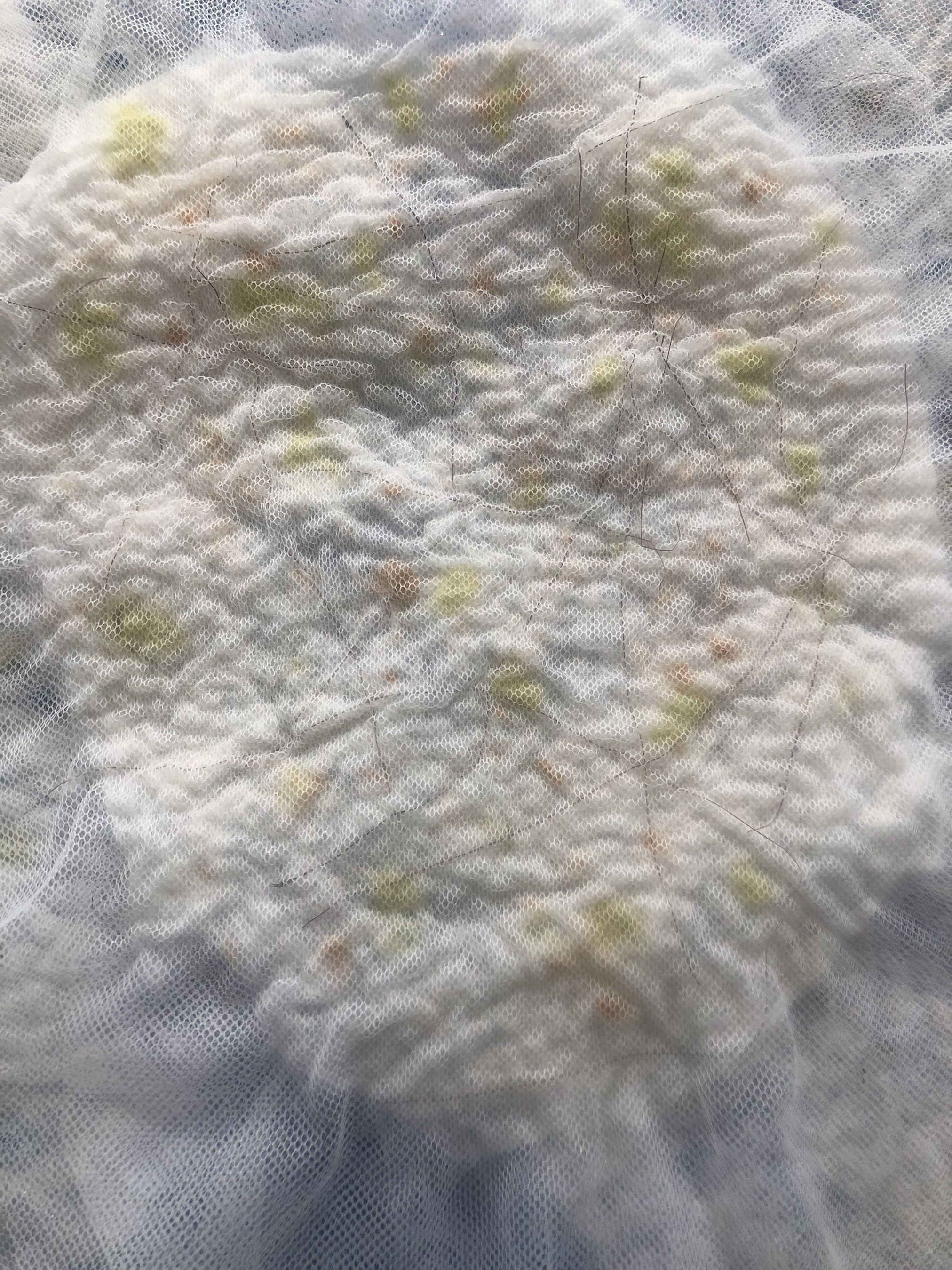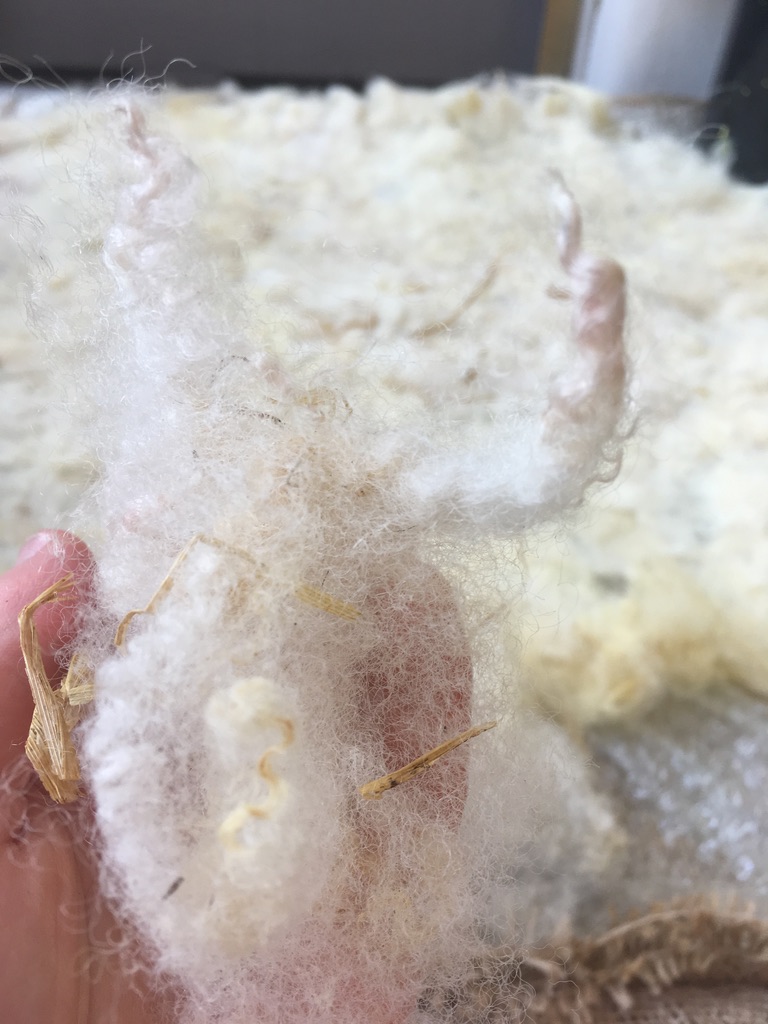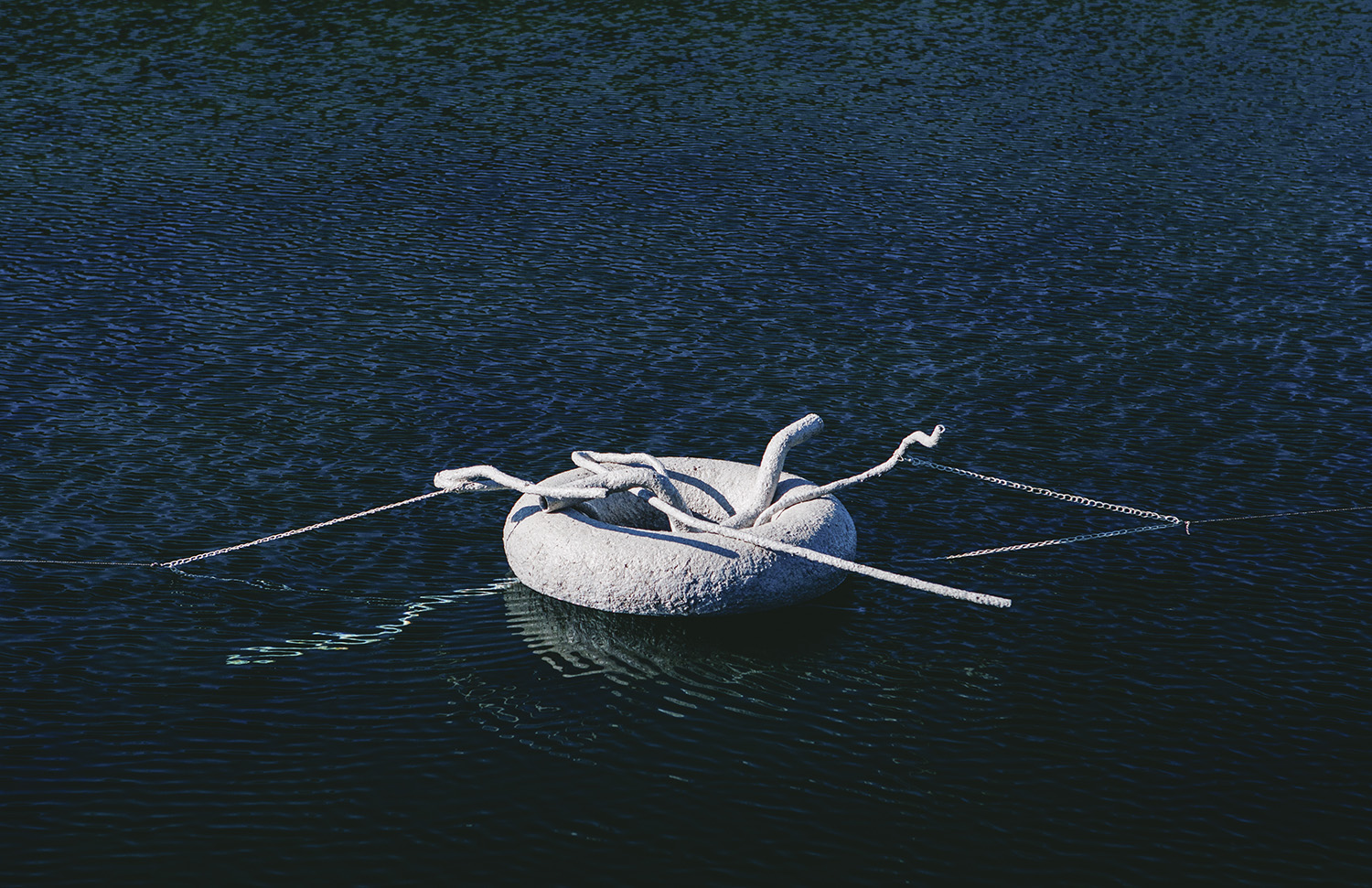Emily Chudnovsky
 Microfiber felt samples. 2024.
Microfiber felt samples. 2024. Micro fibers, raw sheeps wool, grapevine fibers, mesh. Dimensions variable.
BIOMASS: Emily, so glad to have a conversation with you for Volume three! I wanted to start this conversation with your process. Specifically, over the past couple years what have you been developing in or out of the studio?
EMILY CHUDNOVSKY: When I finished my floating piece, Tangle, about a year ago, I took a fairly large break. I was exhausted after doing a public artwork. A lot of strange things happened around that piece. There was some pushback on the ‘natural’ look of the piece from a couple of the residents living in a condo that surrounded where it was floating in a Basin off of Lake Ontario. There was also media interest and support. In the end, the trash trapping program that the majority of the materials for my piece came from is actually now being partially funded by that same condominium. So, after a break I started thinking about this next body of work. I collected invasive grape vines that were being removed from trees from the GTA. I was still thinking about invasive plant species and the invasiveness of microplastic and how to use them in tandem. That brought me back to felting. I felt this desire to take a closer read, likely a response to making this large, and somewhat challenging work that was Tangle.
BIOMASS: When did felting come into your toolkit? Where did you learn that practice? And what do you think made you return to it?
CHUDNOVSKY: I taught myself how to felt during my MFA, when I started working with discarded sheep’s wool on a residency in northern Scotland. This spear-headed my interest in discarded materials. I tend to gravitate toward finding repetitive practices as I test new materials. I'm interested in the way fiber locks together. As I learned more about microplastic through my collaboration with the community research group, the University of Toronto Trash Team, I learned about microfibers – small fibers that shed from our clothing through washing and drying – as well as just being worn out in the world.
BIOMASS: Could you introduce the different organizations that you're involved with and working with at this time? Who is part of your local creative ecosystem?
CHUDNOVSKY: Well, I’ve worked and collaborated with The University of Toronto Trash Team the last couple of years, which is a community outreach organization that operates out of the Rochman Lab, a microplastics lab at the University of Toronto (U of T). They are made up of students, researchers and volunteers, who work with them on citizen science projects, cleanups, data collection, and educational programs. They have a ton of different research projects which focus on science-based solutions to plastic pollution. Then there's also the International Trash Trap Network - they've developed a harmonized data protocol so that around the world, anybody who uses a trash trapping device in a water body can use an app to collect their data on the types of materials they are ending up in their trash traps. The goal is to have a harmonized data set for informing changes. At Western University in the Department of Visual Arts there is The Center for Sustainable Curating, (directed by Dr. Kirsty Robertson). They’re doing lots of interesting work in the realm of museums and environmental and social justice, and are making meaningful curatorial considerations to put on more sustainable exhibitions. And then artists like yourself! I feel like I have a great network of artists who are interested in thinking differently about what and how we produce in light of the current circumstances in which we find ourselves.... That's really inspiring and keeps me very motivated.
BIOMASS: There is such an immense amount of kilometers, miles or depths of water in which we're finding these plastic mediums, that are toxic for water.
CHUDNOVSKY: Yeah… it can be overwhelming to think about.
BIOMASS: I have a question around toxicity, toxicity in relation to care for a broader ecosystem and how we make meaning from our environments. There is this through-line in your work, that walks between interrogating pervasive toxic substances within an environment, And then working with natural fibers, growths, invasive species, or an animal byproduct like wool. You're also transforming them and re-enmeshing them in the studio. What are some of the drives and motivations for you as an artist, maker, researcher, that brings you back to this kind of entanglement between contextually toxic elements and natural or organic ones?
CHUDNOVSKY: I just think that's what we are. We are these once natural things, and ofcourse we're becoming more and more and enmeshed with technology and synthetic matter. We're literally consuming plastic all the time now. I think it's just an interesting and disturbing thing to witness. I'm also interested in how we will respond as well as how the ‘natural world’ responds. So I think part of my practice is looking at these substances together, and how they respond in relationship to each other - I guess in some ways I’m just drawing attention to what I observe to already be at play. Like using the grapevine fibers from these grapevines that are cutting off circulation from trees. They grow at a rapid rate and eventually they tangle themselves to the point of suffocating their host plant. A complicated relationship. I generally aim to work with challenging materials that are in abundance. And like I said earlier, I like to think about how everything, at some point, comes from something natural. At what point does it turn into another ‘category’, so to speak. With plastic because it can't break down, it can't return to an organic original. So the cyclical element doesn't exist. From an artistic perspective I’m interested in how a seemingly more clear-cut material like sheep's wool, fuses with something so mediated like microfibers.
BIOMASS: Could you introduce us to the felt studies and where the ideation emerged from and how you came to some of the ways that that artwork is now existent?
CHUDNOVSKY: So initially, I was focused on the invasive water plants that filter micro plastic - the microplastic clings to the plant fibers and then gets removed from the lake when the water plants end up in a trash trapping device. I made my public art work Tangle, based around this role of plants in addressing plastic waste. After making such an involved work I developed a bit more knowledge around microplastic - And this brought microfiber to my attention.
 Emily Chudnovsky. Material research. 2023.
Emily Chudnovsky. Material research. 2023. Courtesy of the artist.

So much of our clothing is made up of plastic materials which like I said earlier, shed and end up in our waterways, waste streams and in our air and bodies through washing and drying our clothes (as well as while we’re wearing them). The U of T Trash Team did a research project in Georgian Bay, a community in Ontario, with a group called Georgian Bay Forever, where they installed filters on the washing machines in every household in the community. They were able to show that if we all had these filters on our machines (and if the manufacturers developed machines that came with these filters) we could divert hundreds of trillions of strands of these fibers from our waste stream and from our lakes. Trillions! Of course there are lots of questions to be asked about whether we should be making our clothes out of plastic in the first place, but given the fact that we are, this is a very tangible solution. For these experiments with microfibers that I made, I collected microfiber materials from a recycling depot in Toronto that sorts large-scale waste from carpeting and textile wholesalers. Felting is so tactile and textured, it seemed like a useful medium for this kind of study. I was curious also, as to how would the plastic respond to felting. With these new experiments I used a process called Nuno felting, where I felt the sheeps wool and microfibers against a mesh material. They are very subtle, but if you look closely you can see the interplay of the strands of grapevine and microfiber.
BIOMASS: Working in this way and developing essentially your own systems of production, your own methodologies that align with a value system that is not built into either contemporary art or arts education, or the way that most people encounter art in daily life… Do you feel fulfilled by those alignments? I ask because some of the capitalist expectations on our current contemporary art framework do not align with many shared values around conscious creation. So how do you find resonance within this process that exists outside of that frame?
CHUDNOVSKY: Yeah, I mean, it is at times, very hard. But when I do feel fulfilled by these alignments I think I feel the closest to meaning…when I tap into that current, and it doesn't happen all the time. I think it is increasingly harder to do that. But it's more important than ever as it’s glaringly obvious that many of our systems are broken. It's harder and harder to hang on to being an artist. But I don’t really know another way to do it besides developing my own processes. I suppose it brings me a sense of self.
BIOMASS: I think a lot of people are searching for solutions, for community solutions, for methods, despite the fact that almost everything is designed for us to reach out and grab the prefabricated, processed, plastic packed version. These mechanized systems of production and labor, even around creativity keep us from the things that actually sustain creative work and community. In that vein, creating one’s own materials really goes against the grain. Reflecting on the past few years of what you are learning, as an artist and a creative person to renounce learning to let go, or discovering is something that exhausts either your energy, your resources, your propensity for creativity, or your ability to connect and engage. Identifying these things and labeling them can make it easier to let go of them.
CHUDNOVSKY: Yeah, that's something I'm spending a fair amount of time thinking about. And honestly I'm just craving taking a step back, trying to forget about deadlines, social media, and a finished and shareable product for a moment, and enjoy the process of making. It can be scary to hit any kind of a pause. Because there is always the fear that you might get left behind or become sort of irrelevant - definitely a fight with the ego that I think we have to strive to let go of. I get the most joy actually making work and engaging in a dialogue with other artists developing their own lexicon.
Emily Chudnovsky
VOLUME I

Emily Chudnovsky. Leftover. Recycled paper pulp, (cotton grass, wood-shavings, and sawdust), piping, car parts, electrical wire. Dimensions variable. Photo by Alex Hakinson. 2020.


Emily Chudnovsky. Leftover. 2020. View from the tailing pond. Photos by Devin Berquist

Emily Chudnovsky. Leftover. 2020.
Photo by Annie Kierans
BIOMASS: This project Leftover, what ideas, people or materials led to the artwork?
Emily Chudnovsky: In a way I see Leftover more as a research function than a finished artwork. When I was doing a residency in northern Scotland at the Glasgow School of Art’s Highlands and Islands campus, I visited an eco village nearby which was established in the 70’s, called Findhorn. What interested me there were these floating plant hubs which they use to turn their waste into grey water. So they have a series of tanks which contain plants, trees, snails, algae and other microorganisms, and the hubs float inside of these tanks which are modeled on the idea of creating little ecosystems.
B: Like a natural water treatment centre alongside the community?
EC: Yeah exactly. So these floating islands provide a happy hub for bacteria. I found the islands very intriguing and wanted to experiment with an artwork that played with floating plant matter and what might be considered sites of ‘waste.’ And considering the possible aesthetic of these islands was also a draw for me.
B: How did you translate these ideas about sustainable communities and environments? Who or what was involved in that process?
EC: I am always thinking about bringing objects into the world and whether this is still valuable or if it is harmful. That is why using places like the dump and the free store up here for material is so useful for artists, and for everyone really. Even though a lot gets thrown away, so much gets an opportunity for new life. I try to use materials that have been discarded or there may be an excess of saw dust, cotton grass, raw wool and scrap metal. The pulp mill, the dump and the recycling depot up here were all integral to making Leftover. For the arts fest [Yukon Riverside Artist Festival] I showed this piece in a tailing pond, which is a remnant of the mining industry. We have tailing ponds all along the highway up here - they are kind of ‘typical’ to our landscape but were very bizarre to me when I first saw them. They look a bit like craters filled with water.



Pulp process. 2020. Photos by Annie Kierans
B: Some of the formal aesthetic qualities in your work translate some of these more complex ideas which I think is quite impressive. What role has formal training played in your art practice?
EC: I have a strange trajectory maybe because I have a critical theory background, though I have always made artwork. After I did my undergrad I felt really exhausted by academic language... then I went into the art world for my MFA (laughs).! so I mainly used the MFA as an opportunity to hone in on my technical capabilities, accessing the textile studios, the metal and wood shops, and of course making use of the studio space. I am always teaching myself, and so I see my training as ongoing.
B: When would you say you feel most satisfied with your work and also when do you feel like it is done?
EC: I’m never fully satisfied with my work, but I think that just means I want to keep making. Especially because my practice is a lot of teaching myself things, that really makes me feel like I've never reached a finished product. But I think it’s also because a lot of things I make can be undone or unlinked, can decompose, or can be reimagined in another form.
B: When people encounter your work, what do you get out of that experience?
EC: I'm always seeking that kind of alchemy of the idea I see in my mind, the material, where it's going to exist, and the person encountering it. People have different associations depending on their everyday life, they might see more abstract shapes, or they may focus on the material, or the way in which the sculpture is installed. I notice that a lot of the time people want to identify what the materials are that I’ve used, or interact with them in some way, and since the materials are so often meaningful to me I find this to be a satisfying response to the work.

 Leftover. Detail. Photos by Devin Berquist. 2020.
Leftover. Detail. Photos by Devin Berquist. 2020.B: Would you say new work begins with found material?
EC: Most of the ideas I have begin with material. Usually, my initial task or challenge is to get a hold of it. The majority of the pulp mixture for this sculpture is made from sawdust. I went to the pulp mill near here and they were just like ‘Yup, help yourself’; so that was great. This summer I got tons of raw fleece, the farmer picked me up in his boat and took me to his farm down the Yukon river, and we filled the boat with wool. So people have been very generous with me, and that interaction is a wonderful part of it. I think it adds to the magic of the process when the material has already had a strange life of its own and then it provides different challenges and possibilities.
B: Your work has many temporal qualities, like decomposable material, how long to do you hold onto it?
EC: This work is right now living outdoors partially to test its durability … and mostly because I don’t have storage for it (laughter). I’m gonna leave it outside and see what happens. At the moment it’s covered with snow. At some point the paper pulp will disintegrate, without being harmful, and what’s left will be a tire tube and some metal that I got at the freestore which may well return there one day for someone else to make use of.
Emily Chudnovsky's practice consists of collecting organic remnants and synthetic decay in order to draw out new iterations, connections and regenerations through sculpture-based installations. Chudnovsky holds an MFA from the Glasgow School of Art.
